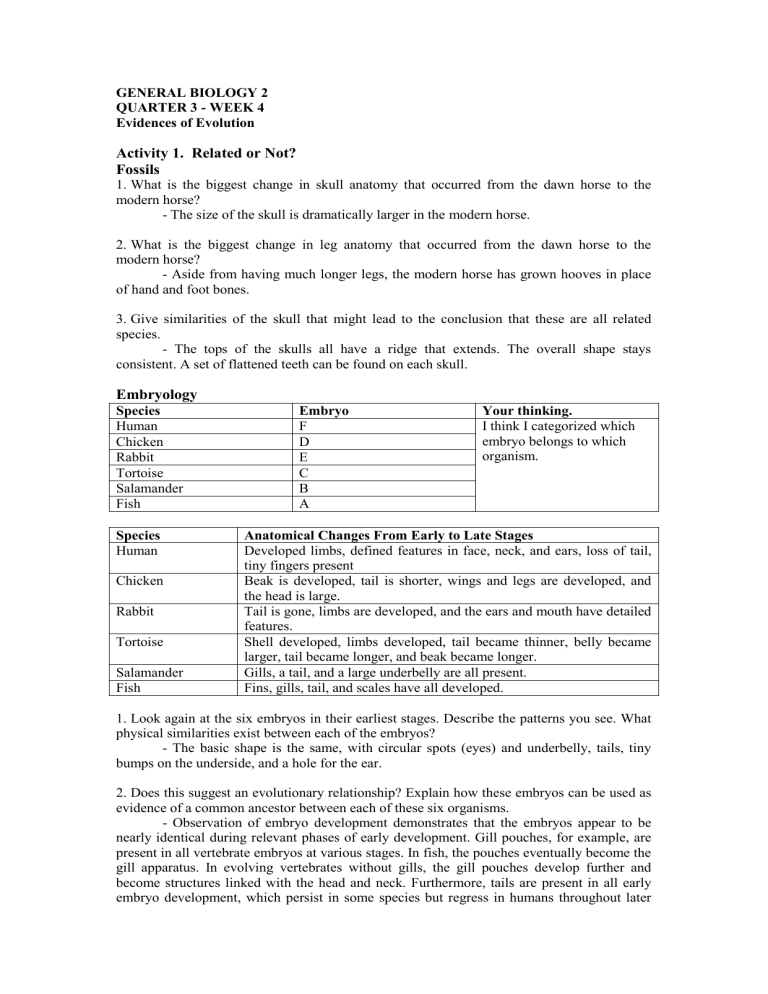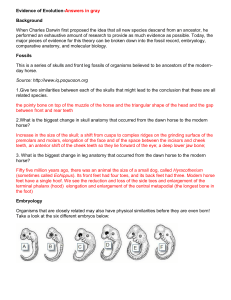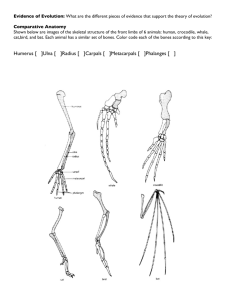
GENERAL BIOLOGY 2 QUARTER 3 - WEEK 4 Evidences of Evolution Activity 1. Related or Not? Fossils 1. What is the biggest change in skull anatomy that occurred from the dawn horse to the modern horse? - The size of the skull is dramatically larger in the modern horse. 2. What is the biggest change in leg anatomy that occurred from the dawn horse to the modern horse? - Aside from having much longer legs, the modern horse has grown hooves in place of hand and foot bones. 3. Give similarities of the skull that might lead to the conclusion that these are all related species. - The tops of the skulls all have a ridge that extends. The overall shape stays consistent. A set of flattened teeth can be found on each skull. Embryology Species Human Chicken Rabbit Tortoise Salamander Fish Species Human Chicken Rabbit Tortoise Salamander Fish Embryo F D E C B A Your thinking. I think I categorized which embryo belongs to which organism. Anatomical Changes From Early to Late Stages Developed limbs, defined features in face, neck, and ears, loss of tail, tiny fingers present Beak is developed, tail is shorter, wings and legs are developed, and the head is large. Tail is gone, limbs are developed, and the ears and mouth have detailed features. Shell developed, limbs developed, tail became thinner, belly became larger, tail became longer, and beak became longer. Gills, a tail, and a large underbelly are all present. Fins, gills, tail, and scales have all developed. 1. Look again at the six embryos in their earliest stages. Describe the patterns you see. What physical similarities exist between each of the embryos? - The basic shape is the same, with circular spots (eyes) and underbelly, tails, tiny bumps on the underside, and a hole for the ear. 2. Does this suggest an evolutionary relationship? Explain how these embryos can be used as evidence of a common ancestor between each of these six organisms. - Observation of embryo development demonstrates that the embryos appear to be nearly identical during relevant phases of early development. Gill pouches, for example, are present in all vertebrate embryos at various stages. In fish, the pouches eventually become the gill apparatus. In evolving vertebrates without gills, the gill pouches develop further and become structures linked with the head and neck. Furthermore, tails are present in all early embryo development, which persist in some species but regress in humans throughout later stages of development. As a result, an animal's individual development is divided into stages that give a broad picture of the stages of evolution or phylogeny of the organisms to which it originally belonged. Comparative Anatomy Animal Human Whale Cat Bat Bird Crocodile Primary Functions Using tools, picking up and holding objects Swimming Running, walking, jumping Flying, flapping wings Walking, hopping Swimming, walking, crawling Compare the skeletal structure of each limb to the human arm. Relate the differences you see in form to the differences in function. Animal Comparison to Human Arm in Comparison to Human Arm in Form Function Whale Whale has a much shorter and Whale fin needs to be longer to help in thicker humerus, radius, and ulna. movement through water. Thumbs are Much longer metacarpals. not necessary, as they don’t need to pick up and grasp things. Cat The humerus is curved, the ulna Cats move by jumping and running, and radius are shorter and thinner, and they're smaller for agility and and the metacarpals and phalanges balance on small ledges. They don't are smaller. have thumbs for grabbing, instead relying on claws and teeth. Bat Humerus, ulna, and radius are The bones are smaller to reduce thinner; carpals are smaller; weight in flight, while the metacarpals metacarpals and phalanges are and phalanges are long to extend the longer and thinner. wings. Bird Humerus, ulna, and radius are Bones are thinner for flight, more slightly shorter; metacarpals are aerodynamic and light fused together, and phalanges are fewer but more pointed. Crocodile The humerus, ulna, and radius are Long metacarpals for swimming and shorter and thicker, the carpals are thicker legs to support heavy weight larger, and the phalanges are pointed. Compare the anatomy of the butterfly and bird wing below. 1. What is the function of each of these structures? - The wings are designed for gliding and flying. 2. How are they different in form? Give specific differences. - A butterfly has two pairs of wings, whereas a bird's wing has many feathers. A bird's wing has bones, but a butterfly's wing has none. Compare the overall body structure of the cave fish and the minnow below. 1. What is the biggest, most obvious difference between the body structure of these two fish? - The cave fish lack eyes and scales, unlike the minnow where it has eyes and scales. 2. Assume the two fish came from the same original ancestor. Why might the cave fish have evolved without eyesight? - There is no requirement for sight because it is always in a dark environment. This adaptation would not have provided a benefit, hence it was not selected. 3. What kind of sensory adaptation would you hypothesize the cave fish has to allow it to navigate in a cave, including catching and eating food? - Sensitivity to motion, vibration, electrical impulses, sound, smell, and/or taste Homologous structures 1. Give an example of a homologous structure from this activity: - Crocodile leg, human arm - Human and cat front legs Analogous structures 2. Give an example of an analogous structure from this activity: - Butterfly and bird wing or bat wing Vestigial structures 3. Give an example of a vestigial structure from this activity: - Thumb of a whale fin 4. Below are some vestigial structures found in humans. For each, hypothesize what its function may have been. Structure Wisdom teeth Appendix Muscles for moving the ear Body hair Little toe Tail bone Possible function? Extra grinding ability for vegetation Store good bacteria to fight infections or digest cellulose like the caecum in rabbits Better hearing by changing direction of ears Keeping warm, preventing germs from reaching mucosal membranes, and trapping pheromones and oil on the body Balance/clinging on rocks/trees Balance, rear stabilizing limb 5. How are vestigial structures an example of evidence of evolution? - Structures that are helpful in other species are often similar to vestigial organs. Humans have a vestigial tailbone that is similar to other animals' functional tails. Vestigial structures might also be considered as evolutionary evidence since creatures with vestigial features are likely to share a common ancestor with organisms with functioning homologous structures. Molecular Biology Animal Horse Chicken Tuna Frog Number of Amino Acid Differences Compared to Human Cytochrome C 5 7 11 9 Animal Number of Amino Acid Differences Compared to Human Cytochrome C Shark Turtle Monkey Rabbit 14 8 1 4 1. Based on the Cytochrome C data, which organism is most closely related to humans? - Monkey 2. Do any of the organisms have the same number of differences from human Cytochrome C? In situations like this, how would you decide which is more closely related to humans? - None of the organisms have the same number of difference from the human Cytochrome C. In circumstances like this, we can determine which organism is more closely linked to humans by comparing anatomy structures, evolutionary tree, or comparing them to human genes using another protein. Charles Darwin published his book On the Origin of Species in 1859. Of the different types of evidence that you have examined, which do you think he relied upon the most, and why? - To link species, Darwin relied on their anatomies being similar. He also had some fossil evidence of minor changes in the species' body structure over time, which often resulted in vestigial structures.



